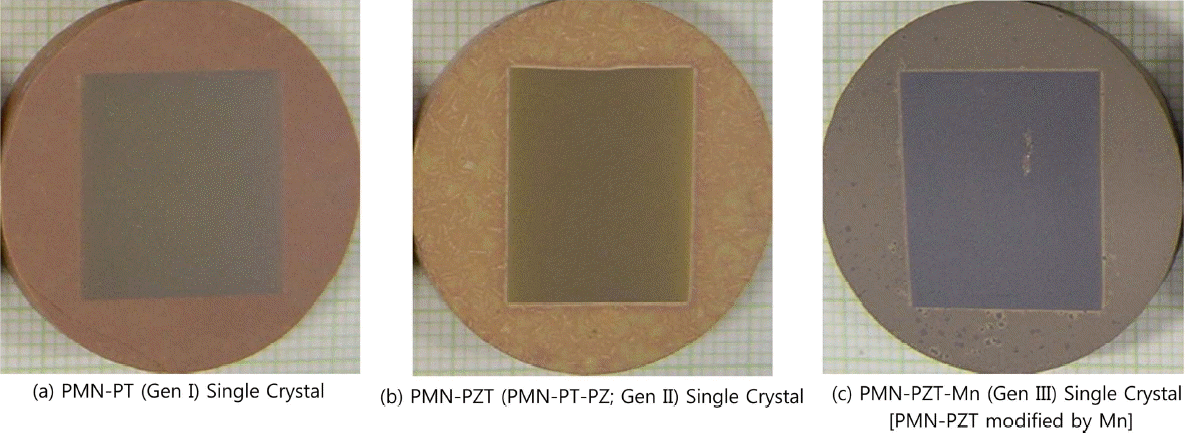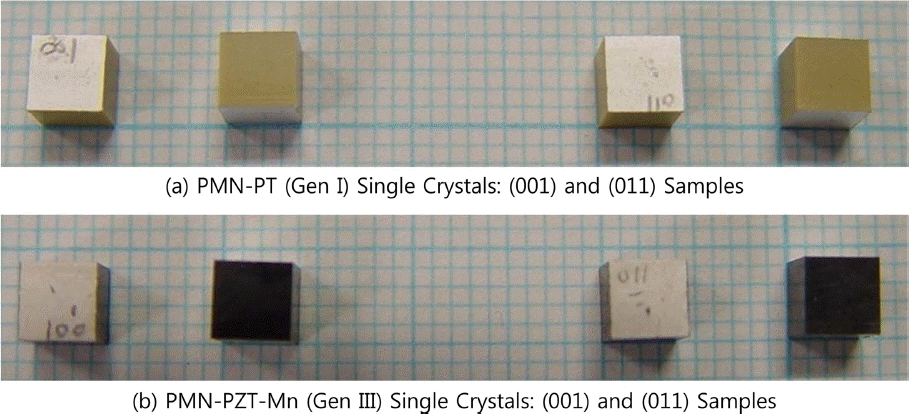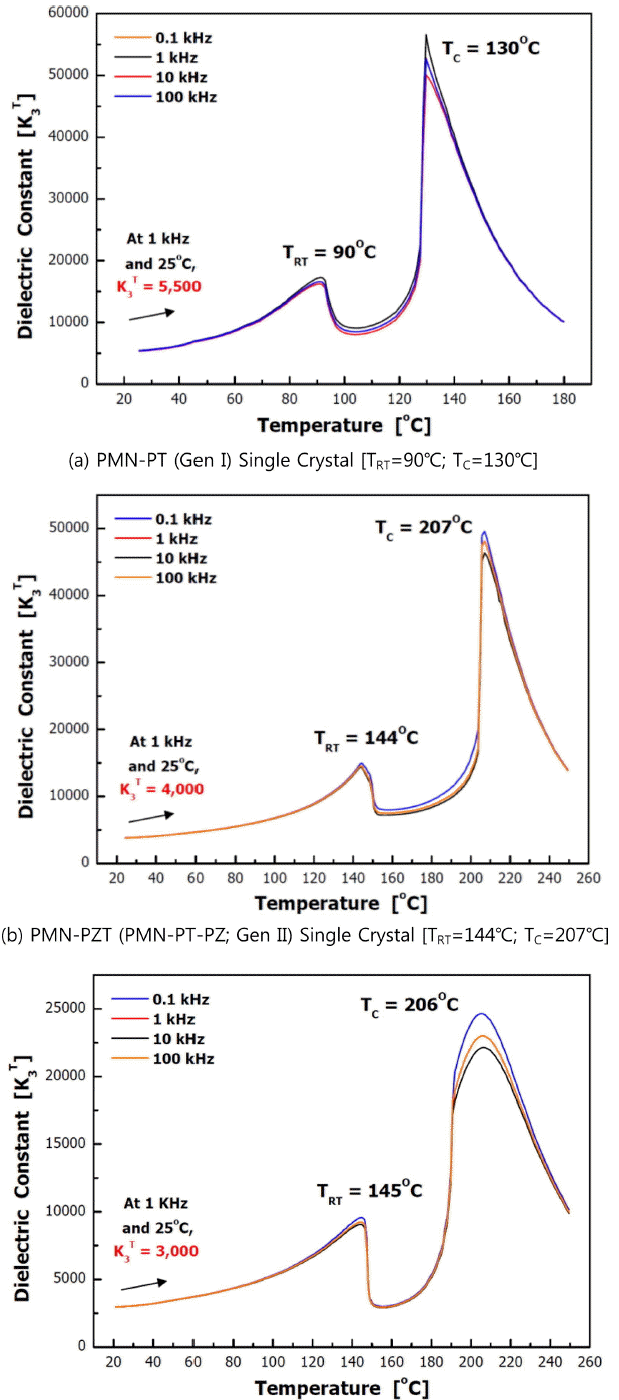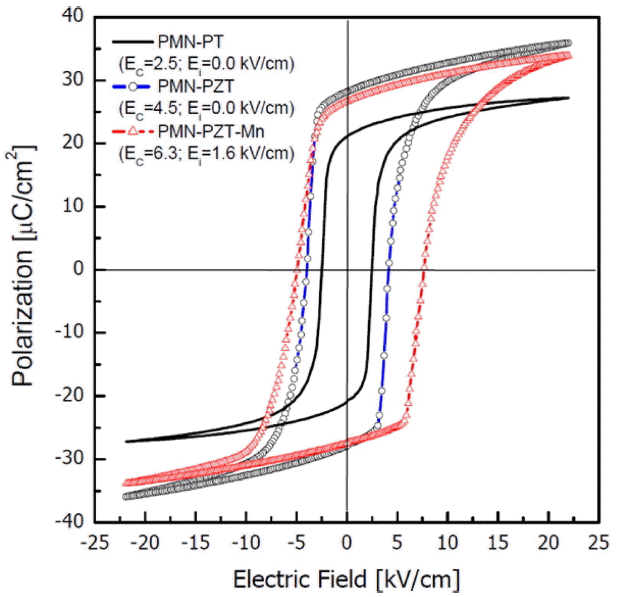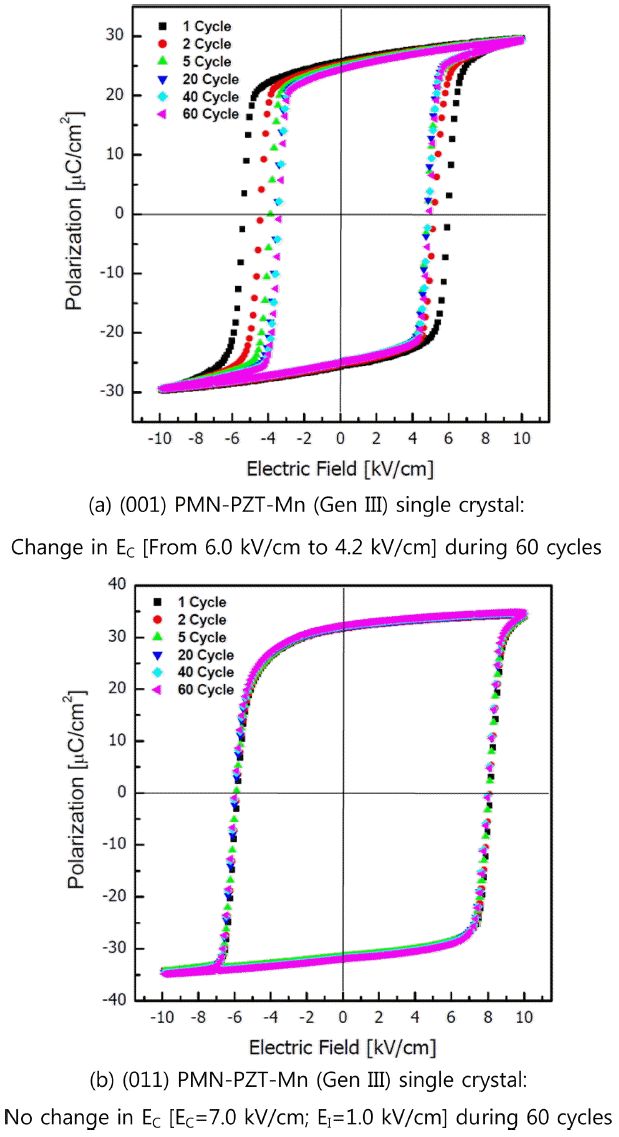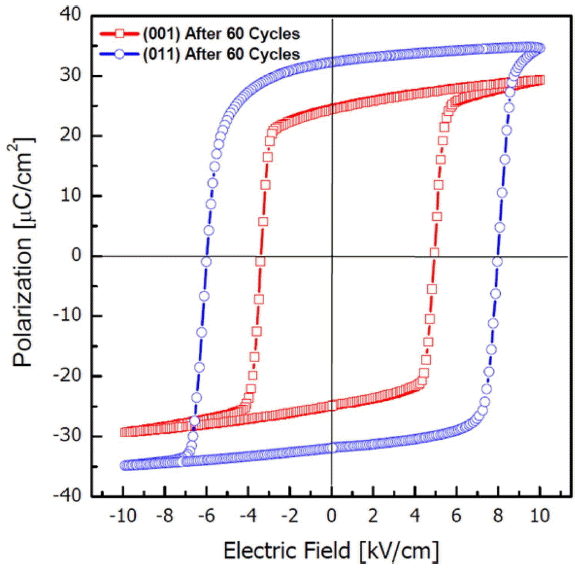1. Introduction
PZN-PT [Pb(Zn2/3Nb1/3)O3-PbTiO3] and PMN-PT [Pb(Mg2/3-Nb1/3)O3-PbTiO3] piezoelectric single crystals, which were developed by Professor Kuwata’s group at Tokyo Institute of Technology in Japan in the 1980’s and by Professor Tom Shrout’s group at Pennsylvania State University in the US, have brought about a huge change in the research and markets of piezoelectric materials and their applications.1-3) The piezoelectric PZT [Pb(Zr,Ti)O3] polycrystal ceramics developed in the 1950’s have been most widely used until now,4) but PZT polycrystal ceramics have dielectric and piezoelectric properties that are very different from those of PMN-PT single crystals. PZN-PT and PMN-PT single crystals have a piezoelectric constant (d33) of 1,500 pC/N or higher and an electromechanical coupling coefficient (k33) of 0.9 or higher. But notably, the d31 and k31 values of the PMN-PT single crystals are higher than those of the PZT ceramics by eight times and two times, respectively (Table 1).
The development of the PMN-PT piezoelectric single crystals was led by the US Office of Naval Research (ONR) and the Defense Advanced Research Projects Agency (DARPA) mainly for application to transducers used in Sound Navigation And Ranging (SONAR) for the navy. The US Naval Undersea Welfare Center (NUWC) and Pennsylvania State University Applied Research Laboratory (PSU ARL) have already developed piezoelectric single crystal transducers for SONAR having excellent performance and a smaller size and are preparing to apply them to other systems and put them to practical use. In the civilian sector, Philips and Humanscan have developed piezoelectric single crystals to apply to medical ultrasonic diagnostic and therapeutic devices. Already, piezoelectric single crystal ultrasonic diagnostic devices developed by Philips, Humanscan, GE, Siemens, and Hitachi are commercially available.
Beginning with the transducers for SONAR and medical ultrasonic diagnostic devices, attempts have been made to apply piezoelectric single crystals to various new fields, including as piezoelectric actuators, piezoelectric sensors, medical ultrasonic therapeutic devices (e.g., high intensity focused ultrasound, HIFU), ultrasonic motors, and piezoelectric energy harvesters.1-3)
While PMN-PT piezoelectric single crystals have large piezoelectric constants (d33 and d31) and electromechanical coupling coefficients (k33 and k31), they have a low phase transition temperature between their rhombohedral and tetragonal phases (TRT) (~ 90°C) and a low coercive electric field (EC) (~ 2.5 kV/cm). As the temperature of the rhombohedral phase PMN-PT single crystals is increased from room temperature, the phase is converted into a tetragonal phase: the temperature at which the phase is converted is defined as the phase transition temperature between the rhombohedral and tetragonal phases (TRT).
Since the dielectric and piezoelectric properties of piezo-electric single crystals are lower at a temperature higher than TRT, the upper limit of the practical serviceable temperature range of the piezoelectric single crystal is TRT. Hence, the extension of the application range of piezoelectric single crystals with excellent properties requires an increase in the phase transition temperature and the coercive electric field. In particular, to apply piezoelectric single crystals to high-power piezoelectric transducers operated at high voltage, it is necessary to increase the phase transition temperature, coercive electric field, and the electrochemical quality factor (Qm) as high as the PZT-4 ceramics.
Table 2 illustrates the recent development of second-generation and third-generation piezoelectric single crystals. The PMN-PT and PZN-PT single crystals with low phase transition temperature and coercive electric field are classified as first-generation piezoelectric single crystals. Those whose application range has been extended because of improved phase transition temperature and coercive electric field are classified as second-generation piezoelectric single crystals, and those with piezoelectric properties that have been optimized by the addition of a donor or an acceptor are classified as third-generation piezoelectric single crystals.
The third-generation piezoelectric single crystals with the added donor have a maximized dielectric constant, piezoelectric constant, and electromechanical coupling coefficient, while those with an added acceptor have a maximized internal bias, coercive electric field, and Qm. Therefore, the third-generation piezoelectric single crystals with an added acceptor may be suitable for application to high-power piezoelectric transducers, such as hard-type PZT ceramics (PZT-4 and PZT-8).
In the present study, first-, second- and third-generation piezoelectric single crystals were prepared and their dielectric and piezoelectric properties were compared. For application to high-power piezoelectric transducers, the properties of the piezoelectric single crystals were compared with those of piezoelectric polycrystal ceramics under high-power operation. The properties of the developed third-generation piezoelectric single crystals were compared to those of piezoelectric polycrystal ceramics (PZT-4 and PZT-8) to investigate their applicability to high-power piezoelectric transducers that are used for SONAR transducers or medical therapeutic devices.
2. Experimental Procedure
The three types of piezoelectric single crystals used in the present study (PMN-PT [Pb(Mg2/3Nb1/3)O3-PbTiO3] (first-generation), PMN-PZT [Pb(Mg2/3Nb1/3)O3-Pb(Zr,Ti)O3] (second-generation), and PMN-PZT-Mn (Mn-added PMN-PZT; third-generation)) were manufactured by Ceracomp Co. Ltd. (www.ceracomp.com) using the solid-state single crystal growth (SSCG) method.5-8) Pb3O4 (99.9%, Alfa Aesar, Ward Hill, MA), MgNb2O6 (99.9%, H. C. Starck GmbH, Newton, MA), and TiO2 (99.99%, Ishihara, San Francisco, CA) powders were used as the raw material powders. The individual raw material powders were weighed and then mixed for 24 hours by a ball milling process. Then, the mixture was dried and calcinated at 800°C. The calcinated powders underwent a secondary ball milling with excessive PbO powder, and the resulting mixture underwent uniaxial pressurized forming and then sintering. Following the primary sintering, the Ba(Zr0.1Ti0.9)O3 seed single crystals were put on the PMN-PZT sintered material, and thermal treatment for SSCG was performed. To prevent the loss of highly volatile PbO, the thermal treatment for SSCG was performed in a double crucible. During the thermal treatment for SSCG, the Ba(Zr0.1Ti0.9)O3 seed single crystals continuously grew into PMN-PZT polycrystal ceramics, resulting in PMN-PZT single crystals having the size of 15 × 15 × 5 mm3. Since the PMN-PZT phase was not melted during the single crystal preparation process by the SSCG, no composition gradient was observed in the prepared single crystals.
The prepared single crystals were cut on the (001) and (011) planes. Ag paste was screen-printed on each of the single crystal surfaces, and the resulting product was thermally treated at 700°C for 10 minutes to form an Ag electrode (fired Ag (5 μm thick)). The dielectric and piezoelectric properties of the prepared piezoelectric single crystals were measured according to the IEEE standards.9,10) The properties of the piezoelectric single crystal and piezoelectric polycrystal ceramics (PZT-4 and PZT-8) were compared during high-power operation to investigate their applicability to high-power piezoelectric transducers that are used for SONAR transducers or medical therapeutic devices.
3. Results and Discussion
3.1. Preparation of piezoelectric single crystals by SSCG
Figure 1 shows the three types of piezoelectric single crystals prepared by SSCG (PMN-PT (first-generation), PMN-PZT (second-generation), and PMN-PZT-Mn (Mn-added PMN-PZT; third-generation)). Single crystals continuously grew from the Ba(Zr0.1Ti0.9)O3 seed single crystals into the PMN-PZT polycrystal ceramics. Since the growth of the single crystals occurs in the SSCG at a temperature lower than the polycrystal ceramics melting point, the shape of the polycrystal ceramics surrounding the grown-up single crystals was maintained even after the growth of the single crystals.
3.2. Electrode-treated piezoelectric single crystals
Figure 2 shows the images of the specimens that were used to measure the dielectric and piezoelectric properties of the piezoelectric single crystals prepared by SSCG (Fig. 1). For testing, the specimens were prepared by cutting the piezoelectric single crystals. To assess the dielectric and piezoelectric properties of the PMN-PZT single crystals, the specimens were prepared in the shape shown in Fig. 2 (4.0 × 4.0 × 4.0 mm3).
The color of the PMN-PT and PMN-PZT single crystals before Mn was added was yellow, while the color of the PMN-PZT-Mn single crystal was black. The prepared single crystals were cut on the (001) and (011) planes, and an Ag electrode (fired Ag (5 μm thick)) was formed on each of the single crystal surfaces. Previous studies have shown that an Ag electrode formed on piezoelectric single crystals has an advantage over other types of electrode in applications where high driving voltage is employed, because an Ag electrode may induce a relatively high coercive electric field.11,12) Hence, an Ag electrode was also employed in the present study to compare the high-power properties of the piezoelectric single crystals.
3.3. Temperature-dependence of the dielectric constant of the piezoelectric single crystals, and phase transition temperature
The (001) piezoelectric single crystals were used to observe the changes in dielectric constant depending on temperature (Fig. 3). The variation in the dielectric constant of each single crystal depending on temperature was observed, and the phase transition temperatures from the rhombohedral phase to the tetragonal phase (TRT) and from the tetragonal phase to cubic phase (TC) were also measured. The TRT and TC of the first-generation PMN-PT piezoelectric single crystal were 90°C and 130°C, respectively. The TRT and TC of the second-generation PMN-PZT piezoelectric single crystal were 144°C and 207°C, respectively, which were about 54°C and 77°C higher than those of the PMN-PT single crystal. The high TRT of the PMN-PZT piezoelectric single crystal means that the practical application temperature range has been extended by about 54°C in comparison with the first-generation PMN-PT piezoelectric single crystal. The TRT and TC of the third-generation PMN-PZT-Mn piezoelectric single crystal were 145°C and 206°C, respectively, which were almost the same as those of the PMN-PZT single crystal, indicating that the addition of Mn of 1 mol% or less had little effect on the phase transition temperature.
3.4. Polarization and coercive electric field properties of the (001) piezoelectric single crystals
The (001) piezoelectric single crystals were used to measure polarization as a function of the electric field, and the coercive electric field (EC) (Fig. 4). The coercive electric field (EC) of the first-generation PMN-PT piezoelectric single crystal was 2.5 kV/cm, and no internal bias electric field (EI) was found because the polarization curve was bilaterally symmetric. The EC of the second-generation PMN-PZT piezoelectric single crystal was 4.5 kV/cm, and no EI was found because the polarization curve was bilaterally symmetric. The coercive electric field of the PMN-PZT piezoelectric single crystal was twice as high as that of the PMN-PT single crystal.
The high coercive electric field of the PMN-PZT piezoelectric single crystal means that the range of available voltage has been widened, and high-power operation has been enabled. The EC of the third-generation PMN-PZT-Mn piezoelectric single crystal was 6.3 kV/cm, and the polarization curve was asymmetrically shifted in the direction of the positive (+) electric field. The asymmetry of the polarization curve was due to the generation of an EI inside the piezoelectric single crystal, and the magnitude of the EI was about 1.6 kV/cm. Such an internal bias electric field is generally found in hard-type PZT ceramics (PZT-4 and PZT-8) to which an acceptor, such as Mn, has been added.
The magnitude of EI is proportional to Qm, and EI is indispensible for high-power piezoelectric ceramic materials requiring high Qm. Therefore, in comparison with the first-generation PMN-PT and the second-generation PMN-PZT piezoelectric single crystal, the third-generation PMN-PZT-Mn piezoelectric single crystal, which has a higher coercive electric field EI, has a wider applicable voltage range and is more appropriate for high-voltage and high-power operation.
3.5. Dependence of polarization and coercive electric field on the crystal direction of the PMN-PZT-Mn piezoelectric single crystals: (001) and (011)
Figure 4 shows that the third-generation PMN-PZT-Mn piezoelectric single crystal has a higher coercive electric field and includes an EI in comparison with the first-generation PMN-PT and the second-generation PMN-PZT piezoelectric single crystal. Due to the wider applicable voltage range, the PMN-PZT-Mn piezoelectric single crystal is expected to be more appropriate for high-voltage and high-power operation. Fig. 5 shows the dependence of the polarization, coercive electric field, and EI of the PMN-PZT-Mn piezoelectric single crystal on the crystal directions of the (001) and (011) planes. The polarization was continuously measured 60 times to analyze the difference between the (001) and (011) crystal directions.
Figure 5(a) shows the variation in the polarization, EC, and EI of the (001) PMN-PZT-Mn piezoelectric single crystal during 60 polarization measurements. The EC was 6.0 kV/cm in the first measurement, but decreased to 4.2 kV/cm in the 60th measurement. As shown in Fig. 5(b), the EC of the (011) PMN-PZT-Mn single crystal was 7.0 kV/cm in the first measurement and remained at 7.0 kV/cm in the 60th measurement with no change. The EI of (011) PMN-PZT-Mn single crystal was 1.0 kV/cm and remained at 1.0 kV/cm in the 60th measurement with no change.
Figure 6 shows the polarization, EC, and EI of the (001) and (011) PMN-PZT-Mn single crystals after performing the 60 polarization measurements. The EC and EI of the (001) single crystal were 4.2 kV/cm and 0.7 kV/cm, respectively, and those of the (011) single crystal were 7.0 kV/cm and 1.0 kV/cm, respectively. In contrast to the (001) single crystal, the (011) single crystal showed almost no variation in the polarization, EC, and EI during the measurement process. The results shown in Fig. 5 indicate that the polarization, EC, and EI are significantly dependent on the crystal direction, indicating that the third-generation PMN-PZT-Mn piezoelectric single crystal in the (011) crystal direction may be more stable in high-voltage and high-power operation.
3.6. Comparison of dielectric/piezoelectric properties and power output between piezoelectric single crystals
Table 3 summarizes the dielectric and piezoelectric properties of the polycrystal PZT-4 and PZT-8 ceramics and the piezoelectric single crystals. With regard to the piezoelectric single crystals, the properties of the first-, second-, and third-generation piezoelectric single crystals are shown for the (001) and (011) crystal directions. In addition, the power output property of the individual piezoelectric materials was compared in terms of figure of merit (FOM), defined as “Qm·d33,” which represents the high-power piezoelectric property.8)
The FOM of the PZT-4 polycrystal ceramic, which is the most widely used material, was employed as a reference for the comparison between the individual materials. The FOM of the (001) PMN-PT single crystal was similar to that of the PZT-4 ceramic. Although the piezoelectric constant (d33) was larger in the (001) crystal direction than in the (011) crystal direction, the FOM of the piezoelectric single crystals were similar to each other, because the Qm was smaller in the (001) crystal direction. The Qm of the third-generation PMN-PZT-Mn piezoelectric single crystal was about five times higher than that of the first-generation PMN-PT and the second-generation PMN-PZT piezoelectric single crystals. Due to the high Qm, the FOM of the PMN-PZT-Mn piezoelectric single crystal was also about five times higher than that of the PMN-PT and PMN-PZT piezoelectric single crystals. These results show that the addition of Mn to a piezoelectric single crystal is necessary for high-power applications.
Table 4 compares the power output of the PMN-PT and PMN-PZT-Mn piezoelectric single crystals [the (001) and (011) crystal directions]. The PZT-4 ceramic was formed in the same shape and used as a reference for the comparison between specimens. In the case of the PZT-4 ceramic, a maximum of 380 Vrms could be applied, and the application of higher voltage caused the mechanical breakage of the ceramic material.
In the cases of the piezoelectric single crystals, the application of the maximum voltage presented in Table 4 caused depoling as well as a drastic decrease in the power output, although no mechanical breakage was caused. With reference to the PZT-4 ceramic, the power output density (Power/(Volume·Vrms) [W/cm3·V]) was 1.40 times higher in the (001) PMN-PT, 2.45 times higher in the (011) PMN-PT, 4.18 times higher in the (001) PMN-PZT-Mn, and 5.29 times higher in the (011) PMN-PZT-Mn.
The results shown in Fig. 3 indicate that the most effective method of obtaining high power output is to increase the Qm by adding an acceptor, such as Mn, to the piezoelectric single crystal. Figs. 5 and 6 show that the (011) PMN-PZT-Mn piezoelectric single crystal may be more stable during high-voltage and high-power operation due to the high EC and EI values. The power output density of the (011) PMN-PZT-Mn piezoelectric single crystal was highest, indicating that it is the most appropriate for high-power applications.
4. Conclusions
In the present study, first-generation (PMN-PT), second-generation (PMN-PZT), and third-generation (PMN-PZT-Mn) piezoelectric single crystals were prepared by SSCG, and the dielectric and piezoelectric properties of the prepared piezoelectric single crystals were compared. The TRT of the PMN-PT piezoelectric single crystal was 90°C, but that of the PMN-PZT and PMN-PZT-Mn piezoelectric single crystals was as high as 145°C. While the EC of the PMN-PT piezoelectric single crystal was 2.5 kV/cm, that of the PMN-PZT and PMN-PZT-Mn piezoelectric single crystals was as high as 4.5 kV/cm and 6.3 kV/cm, respectively. The value of EI found in the PMN-PZT-Mn piezoelectric single crystal was 1.6 kV/cm. In comparison with the PMN-PT and PMN-PZT piezoelectric single crystals, the third-generation PMN-PZT-Mn piezoelectric single crystal showed higher phase transition temperature, EC, and EI, indicating that the PMN-PZT-Mn piezoelectric single crystal is more appropriate for high-voltage and high-power applications due to the wider applicable temperature and voltage ranges.
In comparison to the PZT-4 ceramic, the power output density (Power/(Volume·Vrms) [W/cm3·V]) was 1.40 times higher in the (001) PMN-PT, 2.45 times higher in the (011) PMN-PT, 4.18 times higher in the (001) PMN-PZT-Mn, and 5.29 times higher in the (011) PMN-PZT-Mn. This result indicates that obtaining high power output requires increasing the Qm by adding an acceptor, such as Mn, to the piezoelectric single crystal, and using the (011) crystal direction where high EC is found and EI is present.
The results of the present study showed that the (011) PMN-PZT-Mn piezoelectric single crystal may be applied to high-power piezoelectric applications, such as SONAR transducers, medical ultrasonic therapeutic devices, and ultrasonic motors. In addition, in comparison with the PZT-4 piezoelectric ceramic, the (011) PMN-PZT-Mn piezoelectric single crystal may be used to increase the power output of piezoelectric transducers, operate piezoelectric transducers with low power consumption, and decrease device size.









